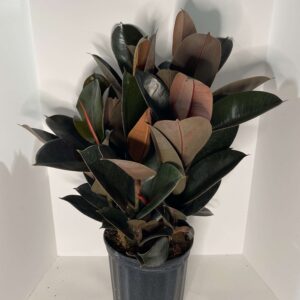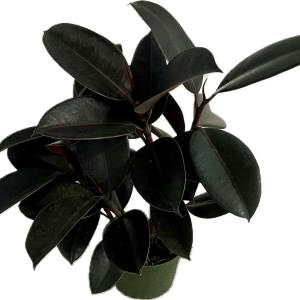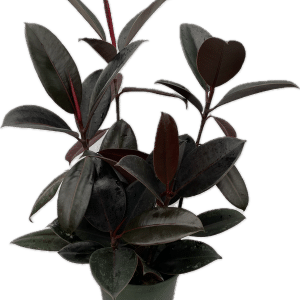A ficus elastica or rubber tree plant, originated in India and Malaysia and was once grown for the rubber produced from its sap; today they are very popular indoor house plants. A rubber tree usually has 5”-12” large, thick, glossy leaves. Once damaged, the leaves cannot be trimmed and should be cut off.
Rubber tree plants do best in medium to bright indirect light. The solid green and dark burgundy varieties can adapt to less light, but the stems may be weak and the leaves small.
These plants are a little difficult to water. Allow the top 25-30% of the soil to dry out before watering. Keep the soil drier when your plant is in lower light or the room temperature is cooler. The leaves turn yellow from under-water and perfectly fine leaves may fall off from over-watering.
Indoors they do well in warm temperatures between 70°F-80°F (21.1C°-26.7°C) with a night-time temperature around 65°F (18.3C). Keep a Rubber Tree plant away from cold drafts, air conditioners, heaters, and fireplaces. Basic household humidity is fine.
Rubber tree plants are susceptible to whiteflies, scale, Mealy Bugs, and thrip.
Rubbers can also get sooty mold, root rot, and leaf spot. Large brown spots along leaf edges usually indicate a fungal or bacterial disease. Remove the diseased leaves, replace the soil, and scrub the container with a mild bleach solution. Keep infected plants away from your other plants.
Rubber tree plants like to be root-bound in small pots so don’t rush to move them to larger containers. Be sure any pot you use has drip holes in the bottom.
Cutting off the growing tip of a main stem encourages the plant to send out new shoots and become bushier. Rubber Tree plants are relatively pest free, but not dust free. It’s important to clean the broad leaves, both for aesthetics and for the health of the plant. Never use milk or mayonnaise to clean the leaves of your houseplants since both attract bugs and clog the pores in the plant leaves. There are several commercial Plant Cleaners available in the stores.



